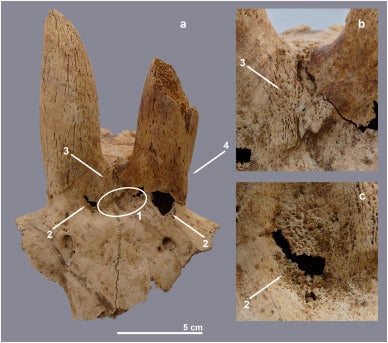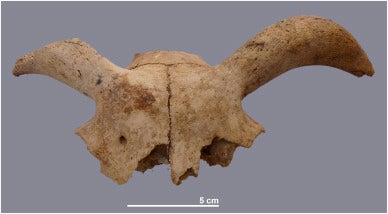Archaeologists have uncovered strangely deformed sheep skulls at an ancient Egyptian burial site, representing the oldest known example of humans modifying livestock horns.
Researchers also found the remains of at least six large, castrated male sheep at the mortuary complex in Hierakonpolis, Upper Egypt, dating to about 3,700 BC.
The ancient sheep whose remains were unearthed had horns not oriented in the natural, lateral direction, scientists say.
Instead, the horns were directed upward, while in some sheep, the horns seem to have been completely removed, say scientists from Belgium who were part of the research.
“The horns had been intentionally manipulated to grow upwards and in three cases this resulted in upright, parallel horns,” researchers write in the study, published in the Journal of Archaeological Science.
Livestock horns are modified across the globe even today as a practice to ensure the animals’ safety from each other, as well as for ease of handling them.
The history of this practice has been traced back to ancient Egypt in previous studies, however, its exact origin remains a mystery.

Ancient Egypt was an agrarian society and livestock, including cattle and sheep were employed throughout the pharaonic period and even during the predynastic period.
Cattle provided meat, bone marrow, fat and dairy products, supporting most of the nutritional requirements of the population.
But for some of the ancient livestock to fulfill their intended roles, they not only had to be handled, but their bodies also had to be physically modified.
One of these processes was the removal or modification of cattle and sheep horns to reduce the likelihood that the animal would gore a handler intentionally or unintentionally.
The oldest known artistic depictions of cattle with deformed horns are found at an elite tomb dating to the Old Kingdom of about 2686 BC to 2160 BC.

Modified sheep skulls found in the latest study appear to be much older.
These Hierakonpolis sheep remains, according to researchers, provide the oldest case of horn modification of livestock by humans, and the first demonstration of this practice applied to sheep.
Analysis of skulls and horn core remains suggests that to bring the horns into a parallel, upward position, ancient Egyptians fractured and tied the sheep horns together at the bases.
The findings suggest ancient Egyptians were already familiar with horn modelling, and confirm that the practice has a long history in the Nile Valley.







